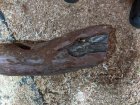Hi, I have an other question about how best to cut up a piece of wood.
I have this log of Texas Madorne , which is very different from west coast madrone btw. As you can see in the pictures it's got a kinda weird inclusion at the end there. It's solid as a rock, no decay in there. I just can't figure out what would be the best way to cut this in hopes of getting at what I suspect to be the yummy good part around that inclusion. Any thoughts would be appreciated. I actually have some more of this and it too has similar strange parts.
Thanks,
Raif
Here is a little video of me rolling the log for a better sense of what it looks like
https://photos.app.goo.gl/133mF6WS9yg3sLMKA
I have this log of Texas Madorne , which is very different from west coast madrone btw. As you can see in the pictures it's got a kinda weird inclusion at the end there. It's solid as a rock, no decay in there. I just can't figure out what would be the best way to cut this in hopes of getting at what I suspect to be the yummy good part around that inclusion. Any thoughts would be appreciated. I actually have some more of this and it too has similar strange parts.
Thanks,
Raif
Here is a little video of me rolling the log for a better sense of what it looks like
https://photos.app.goo.gl/133mF6WS9yg3sLMKA




